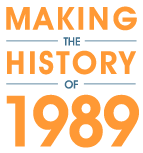Scholar Interviews
Questions
- Vladimir Tismaneanu: What are your personal memories of 1989?
- Bradley Abrams: Which explanation for events in 1989 is most compelling?
- Bradley Abrams: Why was there a communist/socialist return to power in Czechoslovakia?
- Bradley Abrams: What is communism?
- Padraic Kenney: How is Solidarity viewed today?
- Padraic Kenney: How have your ideas changed?
- Padraic Kenney: Did your research lead to a new interpretation?
- Maria Bucur: How have your ideas changed?
- Gale Stokes: What is the larger context within which you interpret the events of 1989?
- Gale Stokes: Why did the revolutions of 1989 happen so fast?
Padraic Kenney: Did your research lead to a new interpretation?
Transcription
There are three basic interpretations of 1989. There is the economic interpretation-- the sort of systemic, economic-political nexus that just Communism fails to work. There’s the issue involving the pressure from Gorbachev as well as opening to the West and so on that are sort of related. And there’s the intellectual ideas aspect.
All three of those are accurate but they’re not sufficient. They’re not sufficient because they don’t help us understand the events themselves of 1989.
The way I would think of it is this: if we imagine a demonstration on the streets of Poland during the late winter and spring of 1989, for example, or later that year, the demonstrations in Hungary or then Prague and Bratislava and we think, okay, how and why are people on the streets.
Now, the problem with the economic explanation is that that’s a long-term thing and it simply does not make sense that people having endured for so many years the difficulties of living in the system, would one day say “that’s it, I’m going out on the street” and “I can’t take this anymore.” You might one day slam down the newspaper and say “I need to be involved someway and look for a movement” but you’re not going to, that day say, “all right, that’s it, I need to go to a demonstration.”
Intellectual ideas—most people were not aware that Havel or Michnik or Konrad were writing these essays. Most people hadn’t read them and it’s difficult to imagine how they would be so immediately influenced, right? We were talking about events that happened very quickly in 1989. They’re powerful ideas, but they’re not the ones that are going to get people out onto the streets.
As for the reform Communists or for that matter, the influence of western leaders, that’s just impossible to imagine that people would say, “Gorbachev is favorable towards change in Eastern Europe. I realize that now.” “If I go out onto the streets today, the U.S. or West Germany or whatever will come to my aid.” None of those make sense and if we want to understand how people get from accommodating to a Communist system to being willing to oppose it, we need something more immediate and concrete.
So none of those explanations get us there. They certainly could factor into people’s understanding, but they don’t get people onto the streets. And that’s where the younger generation, with these new types of social movements that are locally focused, concretely focused, are also based on an idea of kind of personal example. I stand up in order to show that it is possible and that I am not afraid to do so and that actually and this is also of course important if you have people who are brave like that and they stand up and they are shot, then that’s not an encouragement in any way. But if people stand up and it turns out that they get detained briefly or a couple of blows to the back but they stand up again. That is inspiring, and that path does get people out into the streets. This fourth explanation is the only one that gets us to the popular participation of 1989.
